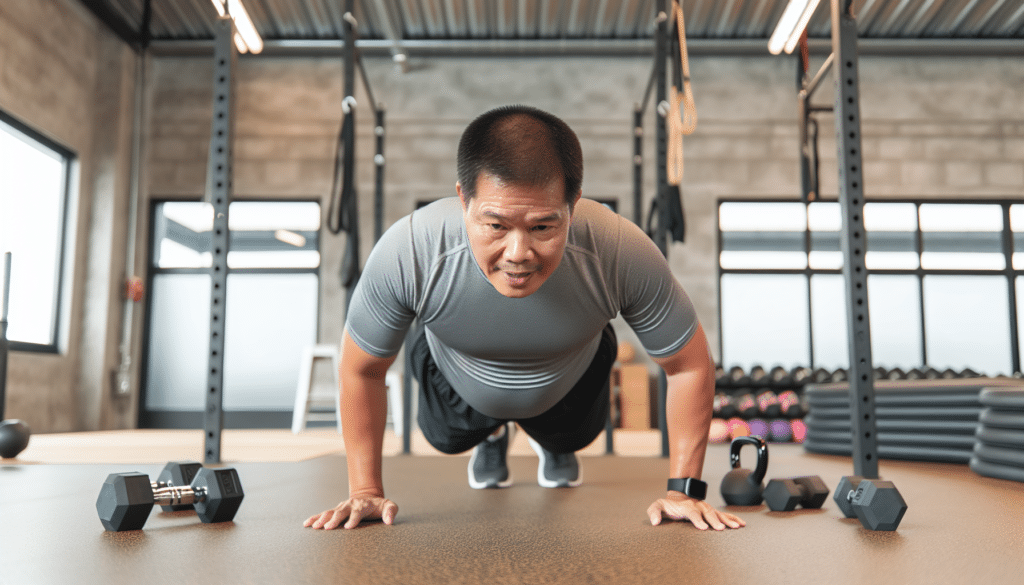When questioning “how many push ups should I be able to do”, the answer can be as personal as your fitness goals.
However, if you want to learn the average number of pushups people your age and gender can usually do, we got you covered.
Dive into this guide to learn where you stand and how to progress effectively.
Jump to:
- Key Takeaways
- Determining Your Ideal Push-Up Count
- Average Number of Push-Ups For Men
- Average Number of Push-Ups For Women
- The Importance of Proper Push-Up Form
- Push-Up Variations for Different Levels
- Building a Push-Up Routine for Progress
- Benefits of Incorporating Push-Ups into Your Workout
- Push-Up Safety and Precautions
- Equipment and Accessories for Push-Up Training
- Summary
- Frequently Asked Questions
Key Takeaways
- The ideal push-up count is highly individualized and should take into account one’s age, gender, fitness level, and personal goals, rather than simply comparing to averages or peer performance.
- Proper form in push-ups is essential for muscle engagement and injury prevention, with focus on correct posture, hand placement, and avoiding common mistakes such as misalignment or incorrect elbow positioning.
- Incorporating a variety of push-up variations and accessories can enhance challenge, target different muscle groups, and prevent monotony, while balancing push-up routines with other exercises ensures comprehensive fitness development and safety.
Determining Your Ideal Push-Up Count

If the question ‘how many push-ups should I be able to do?’ has ever crossed your mind, the answer is more nuanced than you might expect. Yes, push-ups are a universal exercise, but the ideal push-up count varies greatly from person to person.
Don’t be disheartened if you can’t pump out as many push-ups as your gym buddy. Bear in mind, fitness is a personalized journey, and your push-up count should mirror your individual abilities and objectives.
In setting achievable push-up goals, we need to take into account age-based norms and how your fitness capacity and personal targets may influence your ideal push-up number. Keep reading to learn more about how you can tailor your push-up routine to your individual needs.
Age-Based Push-Up Standards
Age has a significant influence on the number of push-ups an individual can perform. Scientific tables categorize push-up performance as ‘excellent’, ‘good’, ‘above average’, ‘average’, ‘below average’, ‘poor’, or ‘very poor’, based on age and biological sex.
For instance, the average push-up counts for adult men range from 23-28 in their late teens to 8-10 for those 60 and over. For adult women, the averages range from 18-24 in their late teens to 5-11 for those 60 and over.
Yet, these figures merely serve as benchmarks. It’s paramount to establish practical and beneficial fitness targets that align with your abilities.
Fitness Level and Goals
Grasping your present fitness level is key in setting your push-up targets to make sure they are suitable and advantageous. If you’re new to push-ups, it might be unrealistic to aim for 50 regular push-ups right off the bat. Instead, setting achievable goals that align with your fitness level can act as a strong motivator in your fitness journey.
For example, if you can only manage a handful of knee push-ups, set a goal to double that number before moving on to regular push-ups. Maintaining focus and consistency in your push-up routine will aid your progress over time.
Average Number of Push-Ups For Men
By Age
According to Strength Level, here’s the number of push-ups men should be able to do, based on their age:

By Bodyweight
And here’s the number, according to their bodyweight:

Average Number of Push-Ups For Women
By Age
According to Strength Level, here’s the number of push-ups women should be able to do, based on their age:

By Bodyweight
And here’s the number, according to their bodyweight:

The Importance of Proper Push-Up Form
Performing push-ups with correct posture is of utmost importance. Proper form not only recruits muscles throughout your chest, arms, abdominals, hips, and legs but also enhances:
- balance
- posture
- flexibility
- sports performance
Furthermore, sticking to the correct push-up stance is vital in protecting against potential injuries, especially those that might impact your shoulders and lower back.
Now, let’s break down the correct technique for performing push-ups and discuss some common mistakes to avoid. With a little practice and attention to detail, you’ll be performing push-ups with perfect form in no time!
Proper Technique and Tips
The first step to a perfect push-up is to start in the correct starting position, which is a high plank position. Your body should align straight from your head to your heels, with your hands positioned under your shoulders. Keep your gaze down for spine alignment, and move with control, lowering until your elbows reach 90 degrees before pushing back up swiftly. Remember to keep your head in a neutral position, and avoid sagging your lower back by contracting your abdominal muscles.
The placement of your hands can also influence the efficacy of your push-ups. Ideally, your hands should be slightly outside shoulder-width, allowing for proper chest engagement while minimizing shoulder strain. During the push-up, press away from the ground, spread your shoulder blades, and aim for controlled speed to reduce joint stress. Also, don’t forget to breathe properly during push-ups by inhaling as you lower and exhaling as you press back up.
Common Mistakes to Avoid
While push-ups may seem straightforward, many individuals fall into common form mistakes that can lead to injuries or less effective workouts. For instance, dropping your head or looking up during push-ups can cause neck strain due to misalignment. It’s also imperative to maintain a correct plank position, with your hips neither sagging nor piking up, to prevent lower back strain.
Moreover, elbows should not flare out widely as this puts stress on your shoulders and reduces chest muscle activation. Always remember to listen to your body and avoid pushing through pain during push-ups.
Push-Up Variations for Different Levels
To maintain variety and challenge in your workouts, it’s crucial to weave in a range of push-up modifications into your regimen. Push-up modifications cater to beginners, intermediates, and advanced individuals, providing appropriate challenges and aiding progress. Here are some push-up modifications to consider:
- Beginner variations, such as knee push-ups and incline push-ups, can help new exercisers build upper body strength.
- Intermediate push-up users can increase intensity with variations like decline push-ups.
- Advanced individuals can challenge themselves with variations like diamond push-ups.
Now, let’s delve deeper into the different variations of push-ups for beginners, intermediates, and advanced exercisers and discover how these modifications can add a new dimension to your workout routine.
Beginner Variations
If you’re new to push-ups, starting with less demanding variations is a proven way to build strength gradually. Wall push-ups greatly reduce pressure on the joints, making them an excellent starting point for novices. Another beginner-friendly variation is the incline push-up, performed with hands on an elevated surface, which uses around 36% to 45% of body weight and helps build upper body strength and stability.
As you gain strength and confidence, you can progress towards traditional push-ups in a straight line and even aim for more push ups.
Intermediate Variations
Once you’ve mastered the basics, it’s time to step up your game with intermediate push-up variations. Diamond push-ups, characterized by the hand position forming a diamond shape under the chest, intensify the workout for your triceps. Another challenging variation is the decline push-up, which elevates your feet to increase resistance, thereby intensifying the exercise for your upper chest and shoulders.
There are also variations like wide push-ups, which involve a broader hand placement to target the upper body muscle, particularly the pectoral muscles, more than the triceps, and sphinx push-ups that strengthen the triceps by starting in a forearm plank and performing a push-up to lift the elbows off the ground.
Exploring a variety of intermediate push-up variations can lead to significant improvements in muscle strength, push-up proficiency, and even enhance your performance in the push up test.
Advanced Variations
Ready for a real challenge? Advanced push-up variations like:
- One-arm push-ups: require significant upper-body strength and balance
- Plyo push-ups: involve explosive strength, with your hands lifting briefly off the ground during the exercise
- Cross-body push-ups: enhance upper body strength and focus on core and hip flexors, involving a rotational hip motion toward the ground
These variations provide a challenging workout and can help you take your push-up game to the next level.
Building a Push-Up Routine for Progress

Incorporating push-ups into your regular workout routine is key to seeing progress. Ideally, a push-up training routine should be practiced three times per week on non-consecutive days, such as Monday, Wednesday, and Friday. But how many reps should you aim for? And how can you balance push-ups with other exercises in your workout regimen? Let’s explore these questions in the next sections.
Frequency and Repetition Recommendations
Regarding frequency and repetitions, it’s vital to find a middle ground. For gaining muscle size and strength through push-ups, targeting the hypertrophy range of 8 to 12 repetitions is recommended. Setting a daily goal for push-ups ranging from 50 to 250, based on your one set max reps, can help you build muscle.
Over time, or as you undertake harder variations, you can gradually increase the number of reps to stimulate muscle growth.
Balancing with Other Exercises
Although push-ups are a superb method to build strength and endurance, they should not monopolize your exercise routine. Integrating a variety of exercises like lateral raises, bodyweight skull crushers, and prone YTWs can establish a well-rounded workout routine and deter overtraining.
Additionally, aerobic exercises such as jogging, cycling, or swimming are vital to incorporate alongside push-ups for boosting cardiovascular fitness and overall health.
Benefits of Incorporating Push-Ups into Your Workout

At this point, you’re acquainted with various push-up modifications, the correct form, and methods to integrate them into your routine. But why should you bother with push-ups in the first place?
The benefits of regular push-up practice extend beyond muscle building. In fact, push-up capacity is significantly associated with a lower risk of cardiovascular disease. Moreover, push-ups primarily target the upper body, engaging major muscle groups like:
- the arms
- the chest
- the core muscles (abdomen)
- the hips
- the legs
This effectively builds muscle strength and offers a practical way to improve muscular endurance.
By integrating push-ups into a cardio circuit with other exercises, you can also enhance your cardiovascular fitness, contributing to holistic improvements in overall fitness.
Push-Up Safety and Precautions
Like with any exercise, safety is of prime importance when carrying out push-ups. A push-up training program should incorporate at least one rest day between each workout day to promote muscle recovery, which is crucial for safety and progress. Moreover, individuals should heed their body’s signals and avoid pushing through pain during push-ups. If you have wrist issues or other health concerns, it’s best to seek professional advice or opt for alternative exercises.
Health Conditions and Injuries
If you carry health worries that could worsen with exercise, it’s crucial to obtain medical approval before initiating any new exercise regimen, especially push-ups. For instance, individuals with a history of wrist injuries should exercise caution and consider modifications like fingers out push-ups to reduce joint pressure.
If you have shoulder or elbow concerns, you should avoid standard push-ups to prevent further injury.
Consultation with Professionals
Regardless of your fitness level, seeking advice from fitness trainers or physical therapists can offer invaluable guidance on the proper form and technique for push-ups. This is particularly important if you’re dealing with injuries or health conditions. These professionals can help you understand the best practices for performing push-ups and can give you personalized advice to ensure you’re doing this exercise safely and effectively.
Equipment and Accessories for Push-Up Training
Although push-ups are a bodyweight exercise that doesn’t inherently necessitate any equipment, specific accessories can enrich your push-up workouts. Accessories such as push-up bars, resistance bands, and weighted vests can elevate the challenge in your regimen, assist you in targeting particular muscle groups, and add variety to your workouts.
Push-Up Bars
Push-up bars, a favored accessory, can render your push-ups more comfortable and efficient. These tools help reduce the risk of wrist injuries by maintaining the joint in a more neutral and comfortable position.
Moreover, the elevation provided by push-up bars enables a deeper chest dip during push-ups, leading to more significant chest, shoulder, and triceps development.
Resistance Bands
Another accessory worth considering is the resistance band. When placed across your back or underneath your hands during push-ups, resistance bands add variable tension to the exercise. This added resistance increases the difficulty of the push-ups, improving muscle strength and endurance.
Weighted Vests
Weighted vests are a great accessory to intensify your push-up workouts. By wearing a weighted vest during push-ups, you can increase the resistance of the exercise, thereby enhancing your muscle strength and endurance.
Additionally, using a weighted vest during push-up training can contribute to maintaining bone mineral density, crucial for preventing bone loss in older adults.
Summary
We’ve covered a lot of ground in this guide. You’ve learned that the ideal push-up count varies from person to person, depending on factors like age, gender, and fitness level. We’ve also emphasized the importance of using proper push-up form and discussed different push-up variations for beginners, intermediates, and advanced exercisers.
Remember, whether you can do five push-ups or fifty, what matters most is that you’re investing in your health and fitness. Keep challenging yourself, maintain proper form, and most importantly, remember to have fun with it.
Frequently Asked Questions
How many pushups can an average man do?
On average, an average man can do about 41 reps of push-ups, which is considered an impressive achievement in terms of strength.
Is 20 push-ups in a row good?
If you can do 20 push-ups in a row, that’s good. Researchers found that every pushup over the baseline of 10 decreases the risk of heart disease, so keep it up.
How many sets of pushups should I do a day?
It’s recommended to do 2 to 3 sets of 10 to 20 push-ups if your maximum is above 50 push-ups. It’s advised to do them every other day for best results.
How can I make my push-ups more challenging?
To make your push-ups more challenging, try different variations or use equipment like push-up bars, resistance bands, or weighted vests. This can help increase the intensity of your workout.
What mistakes should I avoid when doing push-ups?
When doing push-ups, be sure to avoid dropping your head or looking up, as this can strain your neck, and avoid flaring your elbows out widely to prevent stress on your shoulders. Be mindful of your form to prevent injury.















